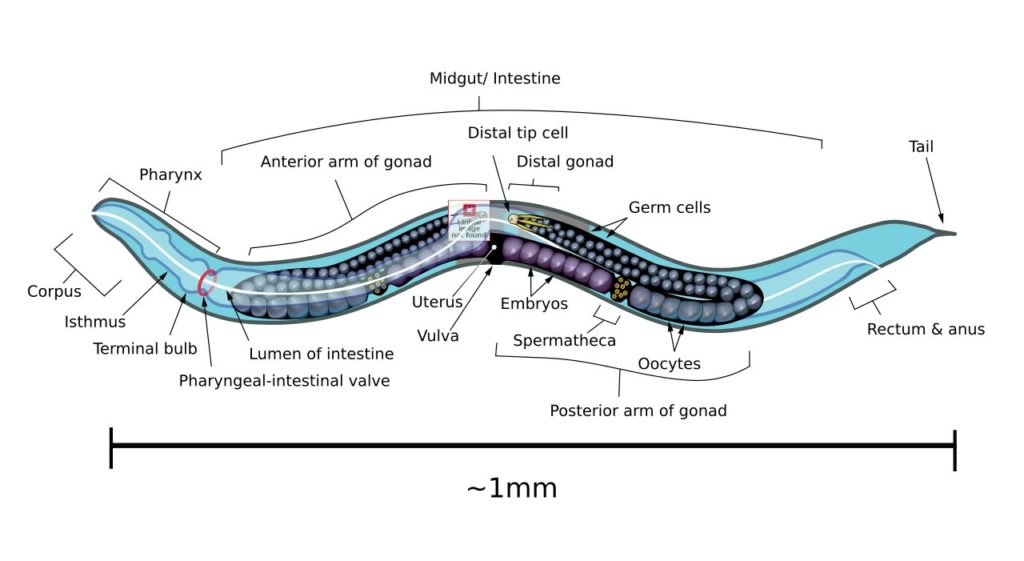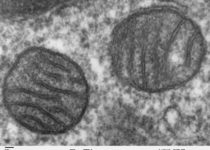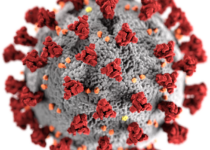C elegans: The Tiny Worm That Has Influenced Biology Research In Very Big Ways

Biology is the study of living organisms. And a lot of biological research so far has depended upon a select few living organisms. These range from tiny bacteria like the E. coli, to large multicellular animals like monkeys. This post describes one such animal, which has been game changing because it is located at a crucial boundary in the level of complexity of different living organisms.
This animal is a worm called C elegans. A worm so tiny that you can only see it under a microscope. We will see what the qualities of this tiny creature are, that make it such a favorite of scientists, and what incredible uses has it has already been put to, including being sent into space, and its entire mind being transferred into a robot, not physically, but electronically, rising questions about the nature of consciousness.
The Beginning
There are two main categories of organisms used in biology research- the microbes and the large animals. And both of them have their own advantages. The microbes, like the E. coli bacteria, are so tiny that literally billions of them could fit in a test tube, making them easy to store. In fact you could keep it in a refrigerator and they would not die. They also grow really fast. One bacterial cell can divide into two daughter cells in just 20 minutes. this means their population will double every 20 minutes.
This means that if for example, you want to study the effect of mutations in certain genes (you can read more about the nature of genes here), you don’t need to wait for years or even months for the organism to grow, to observe the effect. If you were experimenting with the mutation on humans (for sake of argument of course), you would need to wait for years to observe him grow and check for any signs of the mutation affecting his health. With bacteria though, you will see the effect a single day, observing the bacteria carrying the mutation as they multiply and grow. It accelerates the pace of experiments tremendously.
The microbes, however, have a down side. They are genetically so unrelated to us, that if a gene mutation does affect them, you cannot deduce from that, what possible effect that same mutation will have on a human, and that is if that gene is even present in humans. This is why when it comes to research related to human biology, you need fellow mammals that are more closely related to humans, like mice, rabbits, cats, dogs, or even better, monkeys.
These animals though, don’t have the advantages of the microbes. They don’t grow fast (rodents like mice and rabbits do grow fast, but not nearly as fast as microbes), and need a lot of space, food, water and other resources to be kept comfortable. These pros and cons of microbes vs higher animals have prodded scientists to look for organisms that lie somewhere on the borderline, organisms that might inherit the best of both sides, even if to a limited extent. It is this quest, that led Brenner, a biologist, to zero in on the C elegans.
C elegans isn’t a microbe, but a worm. So it is closer to humans, even if not as close as the mammals. And yet it is microscopically tiny, so that literally millions and millions of them can fit in a plate. And they grow super fast, even if not as fast as microbes. A human embryo takes 9 months to develop into a newborn, and 20 years to become an adult. The C elegans takes just 12 hours to turn from an embryo into a juvenile, and just 40 hours to turn from a juvenile into an adult!
And yet, C elegans also has certain advantages of the higher animals. While microbes are single celled organisms, and therefore consist of just one type of cell, C elegans is a multicellular organism, composed of several different types of cells like nerve cells, muscle cells and epithelial cells. And yet, the worm consists of just about a 1000 cells in total. This, along with the transparency of its body, allows researchers to observe every single cell in its body over time. This makes it useful for research on how the zygote differentiates into so many different types of cells, and how these different types of cells interact with each other to make the whole organism function.
These are questions that are relevant to understanding the functioning of the human body, but cannot be answered through experimentation on single celled microbes, since in single celled organisms, you cannot study the interactions between different cells, an aspect crucial to understanding the human body. C elegans lends itself to experimentation for answering these relevant questions, with the unique advantages of easy maintainability and fast growth, that are usually found only with microbes, but also multicellularity and complexity. C elegans, therefore, provides a good balance between complexity and traceability to researchers. In the rest of this post, we will see what vital questions are being addressed through experimentation on the C elegans.
Some Genes Discovered In C elegans Might Help Extend The Human Lifespan
Longevity research is a field of research in biology, that focuses on efforts to extend the human lifespan as far as possible, be it through improved lifestyle choices like healthy food, exercise, sleep, or through discovering genes, biological pathways, or medical procedures, that can extend the human lifespan. We are already coming across new and interesting findings like this study, which claims to have discovered pathways that can expand human lifespan by 500%, although how much difference they will actually make to the human lifespan in the long run, is still unclear.
But discovery of certain genes in C elegans may also eventually help understand the processes that determine the lifespan of humans. In normal conditions, where ample food and water are available, C elegans goes through its normal life cycle from juvenile to adult. But when there is not enough food and water for the worm to survive in its normal state, it turns into an alternate state called dauer. Dauers are capable of surviving without food and water for many months, and go back to normal state once conditions improve.
Certain mutants of the worm, however, fail to enter the dauer stage. Researchers have found that the genes that are mutated in these mutants are genes involved in sensing the changes in environment, genes that control body growth, and most interestingly, genes that control the life span of the worm. And what’s promising is that when this last class of genes is artificially activated, it dramatically extends the life span of the worms, and homologs of these genes have been found to determine the life span of mammals as well!
Worms Within Worms

As can be seen in the figure above, the most prominent organ in the simple body plan of C elegans is the gonad. The worm is essentially a reproductive machine, built around the gonad. C elegans is a hermaphrodite, with each worm having both male and female reproductive organs. The gonad consists of sperm and egg cells, fertilization chamber, and uterus. The fertilization of egg cells with sperm cells happens in the fertilization chamber, the the uterus is where the fertilized eggs turn into embryos, which then exit the mother worm through the vulva. The vulva is an opening formed of just 22 epidermal cells.
Now, here is where a really creepy property of C elegans enters the scene. There are certain mutations that prevent the formation of the vulva in the worm. These mutant worms can still fertilize their egg cells with their own sperm cells, and give rise to embryos. But since they don’t have a vulva, the growing embryos don’t have a way exit the mother worm.
What happens as a result, is that the embryos start growing into tiny worms inside the mother worm, and to grow, start devouring the mother worm itself from the inside, until the mother worm has turned into essentially a skin bag full of juvenile worms inside it. Finally, as the video below shows, the juvenile worms break the surface of this bag and exit it. Yikes.
But these mutations that create worms without a vulva aren’t just a creepy thing to talk about. They have led to some serious insights into how genes in humans might interact with each other, and influence different functions. Since these vulva less worms can be easily identified visually, researchers have been able to identify over a hundred genes, which when mutated, prevent the formation of vulva. And what’s significant is that many of these genes in humans, are either responsible for prevention of cancer, or cause cancer when mutated.
Researchers Have Put The Mind Of C elegans In A Robot And Higher Animals Might Be Next
One of the topics hotly discussed in context of future tech is the possibility of uploading our memory from our brain onto a computer, so that we could outlive our physical bodies and live on as robots. Whether our consciousness will really be retained in this process, and whether this process is even possible, is a debate for another day. But researchers have done something with C elegans, that can be seen as the first baby step in this direction. The number of cells in C elegans is so small that researchers can individually keep a count of them. This is one of the properties that make the worm so useful as a research tool.
It is this small number of cells, that allowed researchers in this particular case, to observe and note every individual neuron in a C elegans, as well as every individual connection between these neurons and how they interacted with each other. Then they uploaded the information necessary to create this entire neural network of the worm into the computer of a wheeled robot. In other words, the robot got the worm’s mind.
In the video below, you can see the robot using the virtual nervous system it got from the worm, to move around in a room. And someone familiar with the movement of C elegans will immediately realize that the robot is behaving exactly like the worm, moving slowly around, stopping when it encounters an obstacle, and changing its path. You are looking at a robot with the mind of an actual worm!
C elegans Has Been Sent To Space To See How Well Humans Would Survive There
Just like studying the cells and genetic pathways in C elegans has led to crucial insights in human biology, including for genes involved in determining lifespan, researchers are now trying to study how human biology would be impacted by a long stay in space, by sending C elegans worms to space and studying how their bodies respond to the new environment. There are two main factors in space that are believed to influence biological systems- lack of gravity and intense radiation.
The effects these two factors on three aspects of the C elegans biology will be monitored, namely the development of C elegans from egg to adult, the activation/suppression of various genes in response to the increased radiation and lack of gravity, and the changes in the muscles of C elegans. The effects on these aspects of C elegans biology are expected to give insights into how the human body would respond to the same conditions in space. This research is necessary now, as we start planning longer and longer space journeys for humans in the near future.
The Cell Death Pathway Was Also Discovered In C elegans
While cell growth and division are rightly seen as processes central to proper growth of an organism, what’s not so widely known is that the planned, systematic death of some of these cells is also equally necessary. You can think of this in terms of how the old leaves of a tree eventually dry, die and fall down. In the human body, some of the cells that would need to die in this way would be cancer cells, and cells infected by harmful viruses or bacteria. The molecular pathway that causes a cell that is no longer needed by the body, to basically commit suicide, was also discovered by researchers in C elegans.
And understanding this process of programmed cell death, called apoptosis, is vital because its failure can prevent cancer cells from dying, causing tumors to grow and spread. The human body, in other words, isn’t just created by a mass of cells growing uncontrollably. It also needs to be chiseled by planned death of certain unwanted cells in the course of its growth and maintenance.



This is nuts! Crazy stuff!
Thank you so much.